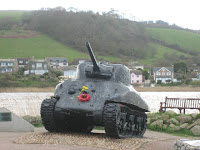Teashop: Ellenor Tea Shop, 11a High St, Otford, Sevenoaks, TN14 5PG
Tel: (01959) 524322
Distance: 4 miles
Map: OS Explorer 147
Parking: There is on street parking around the village green.
Public Transport Otford is on the rail network
Conditions: This walk is over fairly level ground, so the going is generally easy. However the early stages cross riverside meadows and can be muddy after rain.
This walk starts in the High Street car park, just a couple of doors along from the Ellenor Tea Shop. Before leaving the car park it is worth taking the time to view the famous Otford Solar System, built in 2000 as a project to mark the Millenium. The monument is a scale model of the real solar system on a scale of about 1:4.5 billion. The Sun is represented by a brass dome mounted on a stone pillar in the recreation ground. The planets Mercury, Venus, Earth and Mars are also marked by pillars in the recreation ground. The more distant planets of Jupiter, Saturn, Neptune, Uranus and Pluto are indicated by pillars elsewhere around the village and are linked by a marked walk - it takes about 45 minutes if you are feeling energetic enough. They are not part of this walk, but feel free to do it if you like.
1) From the car park in the High Street head west along High Street. Immediately before the bridge over the River Darent turn right along a footpath signed as being the Darent Valley Path, one of several long distance footpaths in Kent.
Although the river has been deepened, channelled and the surrounding meadows drained over the years, it is fairly certain that it was at this spot that the great Battle of Otford was fought in the year 776.
At this date what is now England was divided into a number of different kingdoms, some more powerful than others. Kent had always been relatively rich, but it was small and by 776 was under the domination of King Offa of Mercia. The exact nature of this overlordship is unclear, but a dispute broke out when King Egbert of Kent granted some royal lands to the Bishop of Rochester without asking Offa’s permission first. There then followed further quarrels, the details of which have not been recorded. In the spring of 776 Offa seems to have had enough. He sent Egbert an ultimatum that was refused. War broke out.
Offa mustered the Mercian army and sent it marching to London. In Canterbury people saw a vision of Christ’s cross in the sky bathed in blood. Nobody knew what it meant, but it cannot have been good news. Archbishop Janbert announced that he had studied the details of the dispute and decided that Egbert was in the right. Offa ignored him.
The Mercian army passed over London bridge without incident, then swung southeast to enter Kent by crossing the River Darent at the ford at Otford. The reason why the Mercians had to use a bridge or ford was because of their supply train. At this date an English army would have carried with them a fair amount of camping equipment, cooking gear, food and spare weaponry. The baggage would not have been as cumbersome as it would become later, but even so an army would have needed a large number of pack horses, ox carts and the like.
Offa did not march with his army, he seems to have sent only a part of the force that Mercia could muster – perhaps around 3,000 men or so. Even so the army of Kent would have been seriously outnumbered. It would have made sense to Egbert to try to halt the invasion at a bottleneck in the supply system, and so he came to the ford at Otford.
At this date, the fighting men of both sides would have been infantry - though some may have ridden on ponies when on the march. They were equipped with shield, spear and a sidearm such as a knife or axe. Only the richer men would have had coats of mail or metal helmets. Most men had two or more lightweight javelins as well as their heavy, thrusting spear. These would be thrown toward the enemy in the opening stages of a battle.
The main tactic at the time was the shieldwall. This involved the front ranks closing up and locking shields to produce a solid wall. The rest of the men formed up six or so ranks deep behind. This solid mass of men would then advance on the enemy. It was usual to place the more experienced men at the front to ensure that the face of the formation remained tightly knit and as straight as possible. It is thought that formations usually advanced at a trot so as to combine momentum with the ability to keep formation - though some forces of veterans could run. Once the two sides were locked in combat, it was a matter of spear thrusts and counter thrusts to kill and injure the opposition. Eventually one side or other would begin to lose formation, and often the shield wall broke up completely as an army turned in rout.
Egbert and his men presumably lined the eastern bank of the Darent in shield wall formation. This would have forced the Mercians to splash over the river in order to get to grips, no doubt losing a lot of cohesion in their formation as they did so. It is possible that Egbert held his men back from the ford, luring the Mercians to start crossing, then attacking when the enemy was disordered. Either way the fiercest fighting would have raged about here.
Whatever happened, the battle ended in a stunning victory for the outnumbered Kentish army. The Mercians were chased back to London in defeat. Egbert had won complete independence for Kent and enjoyed that status for the rest of his life.



















